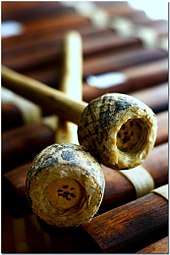Albanian iso-polyphony
| Albanian folk iso-polyphony | |
|---|---|
|
A traditional male group performing | |
| Country | Albania |
| Reference | 155 |
| Region | Europe and North America |
| Inscription history | |
| Inscription | 2008 (3rd session) |
Albanian iso-polyphony is a traditional part of Albanian folk music and, as such, is included in UNESCO's intangible cultural heritage list.[1]
All four regions of Albania, Lalëria (Myzeqe), Toskëria, Çamëria, and Labëria, have the polyphonic song as part of their culture. A related form of polyphonic singing is found in northern Albania:, in the area of Peshkopi; Kaçanik in Kosovo; Polog, Tetovo, Kičevo and Gostivar in Macedonia; and Malësia in northern Albania and southern Montenegro.[2]
Labëria is particular well-known for multipart singing; songs can have two, three, or four parts. Two-part songs are sung only by women. Three-part songs can be sung by men and women. Four part songs are a Labërian specialty. Research has shown that four-part songs developed after three part ones, and that they are the most complex form of polyphonic singing.[3]
The Gjirokastër National Folklore Festival, Albania, (Albanian: Festivali Folklorik Kombëtar), has been held every five years in the month of October since 1968, and it has typically includes many polyphonic songs.[4]
Pleqërishte
Pleqërishte is a genre of Albanian folk iso-polyphony sung by men in Labëria and is principally identified with the city of Gjirokastër and its environs. The genre is characterized by a slow tempo, low pitch and small range.
Pleqërishte means both "of old men" and "of the old time" in reference to the mode of singing and the lyrical themes of part of their songs respectively. In relation to these subjects pleqërishte songs are also called lashtërishte ("of the ancient time"), a term used exclusively in Gjirokastër.[5] These specific topics have largely fallen into public disuse over the years but remain thematically notable.
Songs of the genre adhere to a slow tempo and low pitch with little vocal variation as opposed to genres such as djemurishte ("of young men") in particular.[6] As all fourth-part genres they feature a third soloist (hedhës). While in other four-part genres the hedhës mainly assumes the role of secondary drone a minor third above the keynote, in pleqërishte the hedhës relieves the first soloist (marrës) and allows him to take a breathing break.[5] Each rendition begins with the singing of the first lines by the marrës and the introduction of the second soloist (kthyes) and finally the hedhës. After the hedhës, the marrës's lyrics are repeated by the drone group in various forms and manners.
Pleqërishte songs are exemplified in the repertory of the folk group Pleqtë e Gjirokastrës sometimes regarded as the "last representative" of the genre.[5][7] One of the best-known songs of the genre and most notable renditions of the group is Doli shkurti, hyri marsi, which details a battle between Çerçiz Topulli and Ottoman troops in 1908 in the village of Mashkullorë near Gjirokastër.
See also
References
- ↑ "UNESCO Culture Sector - Intangible Heritage - 2003 Convention :". Unesco.org. Retrieved 2013-09-22.
- ↑ Ardian Ahmedaja, Gerlinde Haid (2008). European voices: Multipart singing in the Balkans and the Mediterranean, Volume 1, p. 210, 243-44. ISBN 9783205780908.
- ↑ Ahmedaja, Haid (2008), p.214-215.
- ↑ Ahmedaja, Haid (2008), p.241.
- 1 2 3 Ahmedaja, Ardian; Haid, Gerlinde (2008). European Voices: Multipart singing in the Balkans and the Mediterranean. Böhlau Verlag Wien. pp. 218–9. ISBN 9783205780908. Retrieved 1 March 2013.
- ↑ Stockmann, Doris; Erich Stockmann (1963). "Die vokale Mehrstimmigkeit in Süd-Albanien". Les Colloques de Wegimont. Cercle Internationale d'Études Ethno-musicologiques. 171: 104.
- ↑ Tole, Vasil. "Inventory of performers on iso-polyphony" (PDF). UNESCO. p. 121. Retrieved 1 March 2012.
External links
Pleqërishte
- Doli shkurti, hyri marsi on YouTube by Pleqtë e Gjirokastrës
- Leshverdha drrullë on YouTube by Pleqtë e Gjirokastrës
